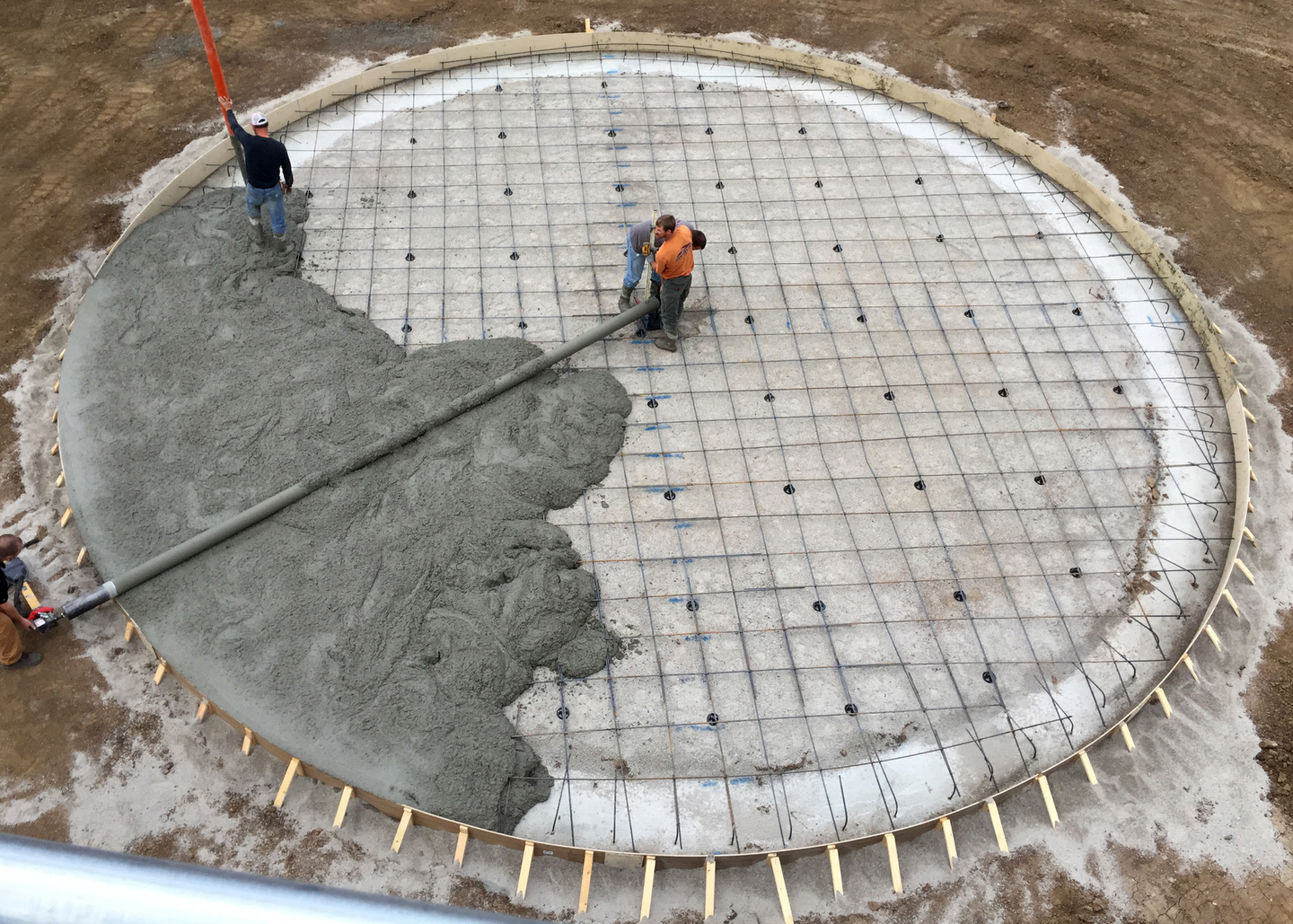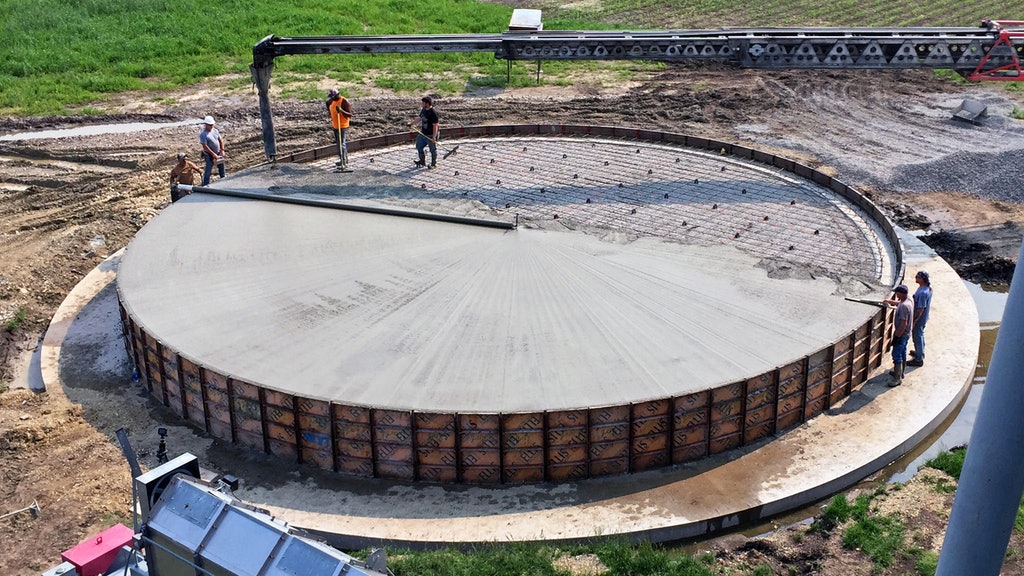Farmers have a lot to manage when it comes to the upkeep of their farm, from sourcing seed to performing routine equipment maintenance. Having the knowledge and proper tools to pivot between tasks easily keeps their operation running smoothly. Even a unique job like pouring a grain bin foundation can be undertaken with tools commonly found around the farm. However, this may compromise the foundation’s quality and lead to expensive repairs down the road.
Investing in specialized tools, even for occasional work, can provide a great ROI with efficient, long-lasting results. To achieve a lasting grain bin foundation, evaluate the options, recognize the drawbacks, and choose the equipment best fit for their scenario.
Where to Begin
Circular concrete pours usually start with a pivot kit. This kit minimally consists of a metal stake fixed to a weighted base. The stake is affixed to the center of the work area and used as a guide to frame out the circular pad. Pivot kits attach one end of a concrete screed to the center stake. Controlled from the other end, the user then screeds off the concrete in a clockwise motion. Any number of concrete screed options can attach to a pivot kit. The most popular methods include hand screeding, using an A-frame screed, or working with a roller screed. But each comes with its own limitations.


Options & Limitations
Hand screeding utilizes a long aluminum or heavy wooden board extended to the center stake and pulled by hand around the circular form. These boards can be a strenuous, time-consuming task. This method may result in structural flaws due to a warped board and uneven concrete dispersion. With structural defects rarely justifying savings, this option leads many to explore the methods implemented by professional contractors, like an A-frame or roller screed. These methods have varying levels of usability, with some more user-friendly than others.
A-frame screeds consist of multiple sections and can be more cumbersome than alternatives. Fins and vibratory attachments hang off the back of the main bar to provide a compacted and smooth finish as the screed pulls, vibrates, and spreads the concrete. However, this design limits screeding to one direction. On the other hand, a roller screed consists of a drive head and pipe. These spin in the opposite direction and are pulled to level concrete. Roller screeds can be electric, hydraulic, or gas motor powered and are typically lighter and easier to maneuver than an A-frame. However, a gas motor can be a limiting factor as it restricts the direction of the spin.
But what’s wrong with only screeding in one direction?
The Challenge With Unidirectional Screeding
Unidirectional screeding is often acceptable for conventional concrete flatwork but less favorable with circular pours. A circular concrete pad can take several hours to place, and unidirectional screeds are committed to screeding one direction for the project’s duration. For efficiency and minimal wasted movement, workers should pour the pad in continuous sections, for example, the first being from 12 to 2 o’clock. After that area is screeded, the next is placed from 2 to 4 o’clock, and so on.
This method might seem compelling. But once the pour is nearing completion and arriving back to the first section, the crew is now pouring and screeding wet concrete next to concrete that has been curing for several hours. Screeding like this creates a cold joint which can cause a division in the uniformity of the concrete pad. Cold joints prevent concrete from curing as one solid, smooth, level foundation. The visual irregularity from a cold joint may leave something to be desired for the concrete pad’s appearance. Plus, it’s also a structural flaw that can result in future costly repairs or possible grain bin failure.

Now, Avoid That Cold Joint
The best method to avoid cold joints is by pouring each section of concrete, alternating the left and right sides of the circle. For example. A section placed at the 12 to 2 o’clock position should have the following section from 2 to 4 o’clock. But unlike unilateral screeding, the third area should then be poured from 10 to 12 o’clock. This alternating pattern ensures every part cures for the shortest amount of time before fresh concrete is placed next to it.
This alternating pattern introduces the utility of screeds with a changeable spin direction. Since all roller screeds need to spin away from the operator, the ability of some screeds to change spin direction at the push of a button allows operators to screed clockwise or counterclockwise effortlessly. This means operators can alternate screeding sections efficiently rather than working in a full rotation and risking cold joints and wasted movement.
Multiple manufacturers offer directional changing features on their screeds, but many do not make the switch easy. Some screeds require the entire drive head of the screed to be removed from the attached pipe, rotated, and reattached to the other side to change the direction. In contrast, other models may feature design features like directional buttons to provide an efficiency that also carries over to maintenance and transport.

Location Challenges: Power
Grain bins are often located in areas that might complicate equipment access and transportation. More importantly, remote locations may limit access to a power supply such as a portable generator or specialized hydraulic equipment. Battery-powered roller screeds address these issues by having no cords or hoses and can be easily operated in remote environments.
Look for a screed that utilizes common 60-volt lithium-ion batteries like those in standard battery-powered drills. Some screeds using such batteries can screed up to 2,500 sq. ft. of concrete on one charge. That is more than enough to screed off any common grain bin pad. The stress-free operation of battery-powered roller screeds combined with minimal assembly significantly lowers the learning curve and operational requirements. Battery-powered roller screeds paired with pivot kits allow any skill level to take on jobs typically out of reach.
Both farmers and contractors are no strangers to recognizing efficient solutions. By recognizing when to use equipment if possible, alternative methods offer time savings and lasting quality that far outweigh the initial investment.

